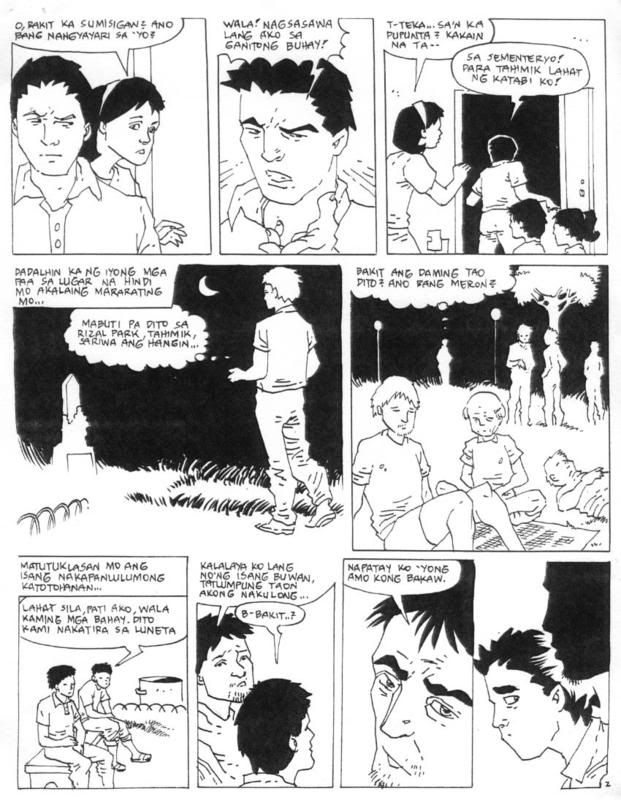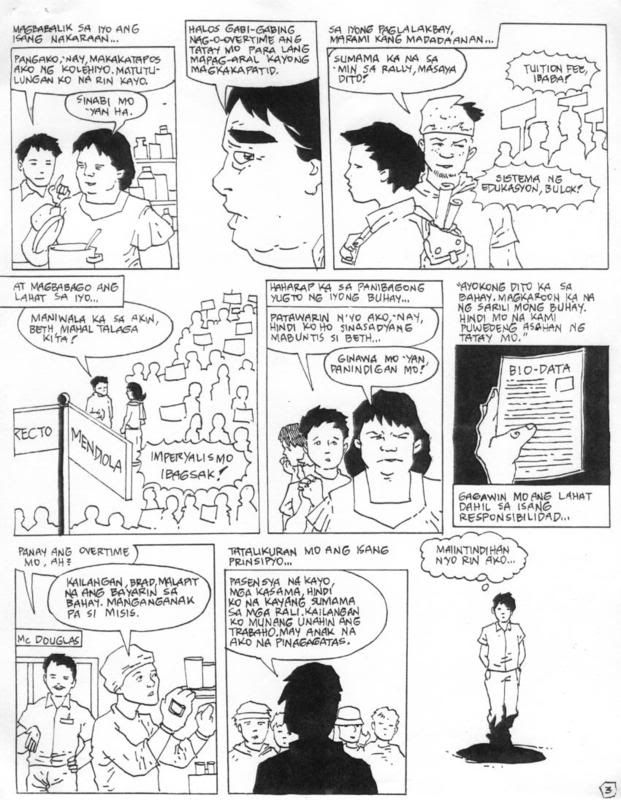MAGHAPONG PAGGAWA
Noong gumagawa pa ako ng mga underground komiks ay mayroon din naman akong mga subjects na malumanay. Ilan sa mga ito ay may temang social realism. Paborito ko ang subject na ganito dahil tingin ko ay dito ako nahubog sa pagsusulat. Hindi kasi ako lumaki sa pagbabasa ng mga Harry Potter o ng mga Lord of the Rings, o ng mga Sydney Sheldon at Tom Clancy, mas na-exposed ako sa mga Ernest Hemingway, Kahlil Gibran, Lope K. Santos, Lualhati Bautista, Edgardo Reyes, kaya siguro pagdating sa subject matter ay hindi ako masyadong nag-i-enjoy sa mga fantasy stories. Sa pelikula siguro, lalo ngayon na magaganda na ang special effects. Pero pagdating sa libro, mas gusto kong makabasa ng totoong buhay, kaya siguro ang hilig-hilig ko din sa mga documentary films.
Kung mapapansin ninyo, may eksena na naman dito ng Luneta o Rizal Park. Paborito kong subject ang Luneta dahil ang daming kuwento dito. May buhay ang Luneta lalo na sa gabi. Una akong naging laman ng Rizal Park noong 1997, naging tambayan ko ito halos linggu-linggo kapag gusto kong mag-relax at pampaalis-umay sa bahay. Marami akong nakasalamuhang tao dito, mula sa mga gangster, ex-convict, prosti, eskobador, manlalaro ng chess at dama, debatista ng relihiyon, mga tindero sa bangketa, at iba pang mukha ng pangkaraniwang Pilipino.
Ang natatandaan ko ay isinali ko pa ang komiks na ito sa pa-contest noon ng Amado V. Hernandez Resource Center, pero hindi nanalo. Siguro dahil hindi naman talaga tungkol sa manggagawa ang subject ko dito, kundi tungkol sa 'love and contentment'. Isang subject na sentimental at madrama, pero tingin ko ay ang pinaka-importanteng lesson na dapat nating isabuhay sa panahon ngayon na marami nang nararanasang problema ang mundo.
Paki-klik lang po ang mga pahina para sa mas malaking imahe. Maligayang pagbabasa.






4 Comments:
nice story, nakakarelate ako. :)
sana may mag publish naman ng mga ganitong uri ng komiks anthology na makabuluhan. may social relevance. may aral.
tapos siyempre maganda print quality para swak! :)
Randolph:
This is the reason why I like UNPLOTTED stories like this one. What's more, it so happens also that I like short stories with the so-called "a day in the life" approach because it holds me as a reader. This is what STERLING should have done with their short features. Unstructured and unplotted. Though it is more challenging for the writer to do, the pay-off is pretty good and the reader is more challenged cerebrally.
Not that I condemn plotted stories. They are good in their own way, especially if written carefully and therefore, free of loopholes. That said, the only problem with plotted stories is that the readers tend to "EXPECT" something, because they are quite aware that in the end, there will be something in store for them.
This reminds me of what author
Damon Knight wrote in his book, Creating Short Fiction:
"You know this story, but in case you have forgotten: A man in a rooming house was in the habit of taking off his shoes at night and dropping them on the floor one at a time, with a pause for rumination in between. The lodger below had complained about this many times. One night, after dropping the first shoe, the man suddenly remembered the complaints and put the second shoe down gently.
After twenty minutes had passed, an agonized wail came up from the floor below: "For God's sake, drop the other shoe!"
In one way or another, every plotted story makes us wait for the other shoe to drop. We are waiting for the resolution of a conflict, or the solution to a puzzle, or the explanation of a mystery, or just the completion of a pattern, and it is this anticipation, as much as anything else, that makes us read on."
Therefore, I will have to quote SIMON COWELL's favorite expression in American Idol: "it is SAFE to write a plotted story."
And I'd say that it is more daring to write an UNPLOTTED one.
ano ba talaga ang simpleng paliwanag sa tinatawag na unplotted story? ung plotted ba ay ung nakakahon lang sa mga pattern na ginagawa ng mga writer? salamat.
-joey
Joey:
Unplotted character Stories are often called MESSAGE STORIES because of their strong underlying theme. Writers, however, classify them as unplotted character stories, and , as such, they must follow a clearly defined FORM to be effective.
For the untrained, identifying an unplotted story can be difficult because the main character may often have a purpose and have to reach a decision. The unplotted story must also contain the basic element of all other types of stories:
Rule 1: Someone to root for
Rule 2: Something of importance, which must depend on the outcome
Rule 3: A definitive beginning, middle and end.
The difference in an unplotted story is: the purpose (goal/decision) of the main character is NOT the focal point of the story, and often, is not present in the beginning of the story. What is important is the REACTION of the main character to the unique situation in which he finds himself, or into which he is pulled, which is used to illustrate some truth-of-life that the author wishes to convey.
Now, there are five main types of unplotted character stories:
1. Character defeated because of circumstances
2. Character defeated because of weakness or obsession
3. Character prevails because of great sacrifice
4. Character regeneration
5. Character degeneration
Joey, it will be rather lengthy to explain all of it here, so try visiting my blog and you’ll get the whole shebang, since this is exactly what I have posted recently there. I am really surprised how many young writers are so confused about the difference between Plotted and Unplotted stories. So far, there were 5 people wanting to know what exactly is the difference. We can only thank Randy Valiente for triggering this topic by posting his komiks story here.
pinoy-comics-tv-movies.blogspot.com
Post a Comment
<< Home